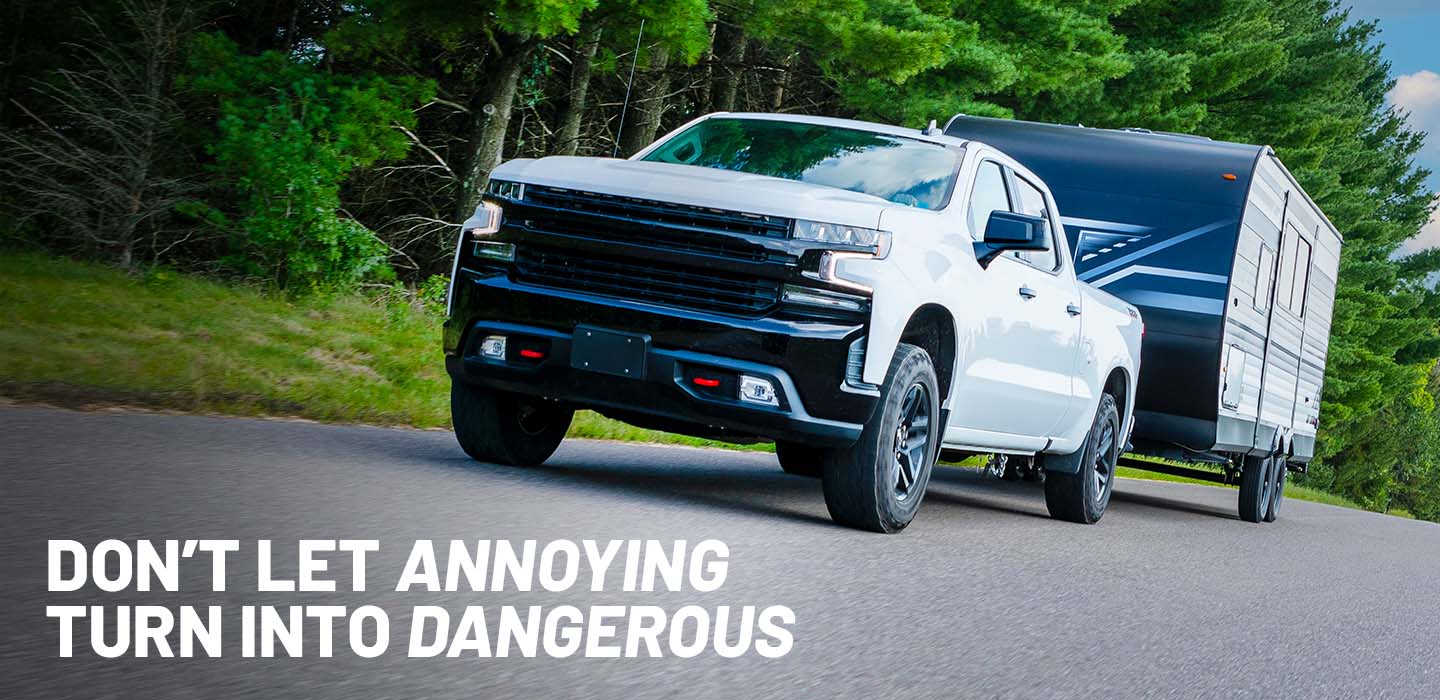
How to Stop That Pesky Trailer Sway
Share article
Have you ever been driving down the highway, and suddenly, out of nowhere, someone goes flying past you in the next lane with their trailer rocking side to side like a fish through water?
Or worse, has this swerving side-to-side motion ever happened to you?
This back-and-forth motion is called trailer sway, and it’s not only obnoxious. It can become downright dangerous if left unchecked.
In this blog post, we’ll talk about the causes of trailer sway and four methods to prevent it.
What is Trailer Sway?
Trailer sway or just “sway” is a lateral, back-and-forth motion that can occur when towing a trailer. During a sway event, the trailer pivots side-to-side on its hitch connection point like a pendulum. This lateral movement causes the trailer to be continuously out of alignment with the tow vehicle as it travels down the road.
Trailer sway can be slight or aggressive and can range from a mere annoyance to a potentially hazardous condition. It can also affect the tow vehicle in varying degrees, even leading the vehicle and driver to lose control.


What Causes Trailer Sway?
Let’s say you’ve outfitted your vehicle with all the right towing equipment, you’ve hitched up your trailer flawlessly, and you’ve just embarked on your journey only to be plagued by an incessant jostling and shaking from the trailer.
Gritting your teeth, you ask yourself, “Why is my trailer swaying? I did everything right!”
As it turns out, buying the right towing accessories and hooking up correctly don't necessarily guarantee a fool-proof solution to reduce sway.
The truth is, the number-one cause of trailer sway is improper distribution of weight. This has to do with how you load your trailer. If your trailer is out of balance, so to speak, a fancy new hitch accessory won’t solve the problem.
Other Causes of Trailer Sway:
- Changing lanes too quickly
- Passing vehicles
- Crosswinds
How to Prevent Trailer Sway
The first step in preventing sway in your trailer is to load it properly. A trailer relies on a specific balance of weight across its axle(s). When this weight isn’t distributed correctly – that is, when too much weight is loaded in front or behind the axle – the trailer can’t perform as intended.
1. Load Your Trailer Following the 60/40 Trailer Rule
The ideal distribution of weight is 60/40, meaning 60% of the weight in front the axle and 40% behind the axle. This creates the precise amount of tongue weight – the downward force at the hitch connection – that the vehicle and trailer need for safe, smooth towing.
This doesn’t mean you need to weigh each item and draw up a detailed plan to make sure the weight is perfectly distributed.
The 60/40 trailer rule is a guideline. Follow it as best you can.
When loading your trailer, be intentional about adding more cargo in front than in the rear of the trailer. However, don’t overdo it. It’s 60/40, not 80/20 and not 100/0. It’s also not 50/50.
When your trailer doesn’t follow the 60/40 rule, you’ll know it.
If too much cargo is loaded in front of the trailer axle, it can lead to poor braking conditions. If too much weight is placed behind the axle, it will lead to – you guessed it – trailer sway.
2. Add a Sway Control Unit or Two
A properly loaded trailer is the number-one best thing you can do to avoid trailer sway. However, it doesn’t always prevent the unexpected.
Crosswinds and passing vehicles can send your vehicle-trailer combo into a sway event.
To add more resistance to this side-to-side motion, you can add a sway control unit to your hitch connection. A sway control (or colloquially “trailer sway bar”) is a simple device that installs between your hitch and trailer tongue and restricts movement using a brake-pad-like bar. A sway control helps combat annoying back-and-forth movement while still allowing the vehicle and trailer to turn as needed.
Two sway controls are actually recommended, and they work best when installed together with a weight distribution hitch.


3. Get Sway Control & Weight Distribution in One
While many weight distribution hitches offer compatibility with a sway control unit, some are equipped with integrated sway control technology.
The TruTrack™ weight distribution system is a highly engineered device that both levels your vehicle-trailer combination and resists trailer sway, giving you exceptional control on the road. TruTrack uses an innovative spring and cam system, built into the head, as well as fixed support brackets to keep the trailer aligned and towing smoothly.
4. Invest in Sway Command®
Sway Command is an electronic solution to sway control. It uses microprocessor technology and your electric trailer brakes to actively respond to and combat trailer sway.
In the event that your trailer begins to sway, Sway Command will automatically apply the trailer brakes – even before the driver has a chance to react – to help combat and contain the swerving motion.
The device mounts onto the exterior of your trailer and simply gets wired into the electric brakes.
Discover How Effective Sway Command Can Be!
Disclaimer: These photographs, recommendations, and approximations are intended for demonstration purposes only and do not reflect the specifications of any particular tow vehicle, recreational vehicle, or trailer. Always consult the manufacturer’s Owner’s Manual.




